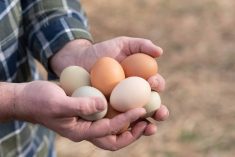If you’re a little worried about the upfront cost of putting in this year’s crop, Farm Credit Canada’s 2023 economic outlook might put your mind at rest.
While this year’s costs of production are poised to match or exceed last year’s record as the most expensive crop ever, FCC’s outlook indicates it may also be a lucrative year for farmers. Here’s a snapshot of what FCC’s senior economists said is in store and what that means for you.
During FCC’s 2023 Economic Outlook virtual event earlier this year, FCC’s chief economist, J.P. Gervais, broke down the economic trends, such as inflation and interest rates.
Read Also

Health hazards are often overlooked risks on the farm
While quite different from the dangers posed by farm machinery, hazards such as loud noise or sun exposure require the same proactive attention, the Canadian Agricultural Safety Association says.
The record inflation rates that characterized 2022 are starting to trend downwards. However, it will take time to reach the Bank of Canada inflation-control target range.
“I’m confident that by the end of 2023, we’ll have inflation heading towards the upper range of the Bank of Canada target. But I do think that will take a little time,” said Gervais.
There’s also good news about interest rates. After the Bank of Canada increased its target for the overnight interest rate by 25 basis points in January, it held the rate at 4.50 per cent in March. Gervais said the January increase “will be the last increase we get as part of this cycle of higher interest rates that started out in 2022. That’s going to be the last one in 2023.”
However, expect the overnight interest rate and short-term interest rates in general to remain “elevated” for most of 2023. Long-term rates have already come down “in anticipation that we’re approaching … the peak for the overnight rate,” said Gervais.
And will long-term rates decline any time soon? “I would argue that perhaps we’ve seen as much as we’re likely to see in 2023.”
Gervais also cautioned against expecting the Bank of Canada to cut back its overnight interest rate in the event of an economic slowdown in Canada.
Another positive trend is supply chains are being re-established and “getting back to some sort of normality.” One exception is the farm equipment sector, but, overall, supply chains are “mending,” said Gervais.
However, one source of inflation that is not changing for the better is the tight labour market, which will continue in 2023. All levels of the food supply chain are showing a job vacancy rate higher than the average for all of the sectors in the Canadian economy, said Gervais.
“We have a real issue, a real challenge in front of us that we’re going to have to address with a number of different strategies on the labour front — retention, automation and so forth.”
A low-Canadian-dollar environment will prevail in 2023 with a lower value for the first half of the year and a higher value the second half. This is driven by the state of the global economy, said Gervais.
“There will likely be a global economic slowdown of some kind. We’ve seen central banks around the world … raise interest rates to rein in inflation in all parts of the world.
“That should in and of itself slow down economic growth to the point that perhaps the demand for oil could slow down as well a little bit, and that explains the drop in the first six months of the year for the loonie in our forecast…. At the end of the day, it’s all about the health of the economy and we expect it to be a little bit weaker for the first six months and a little bit stronger towards the end of 2023.”
Desmond Sobool, FCC’s principal economist, said to expect volatility to continue in 2023, but we won’t “see it at the same pace we saw in 2022, even though the (Russia-Ukraine) war remains a major wild card for ag markets.”
He’s “cautiously optimistic” even with the prospect of an economic slowdown this year.
“Overall, 2023 is going to be a strong year. We’re seeing there will be strong revenues, so that is something good for the ag sector and crop production,” said Sobool.
A strong demand for food is being driven by food security and the decreasing stocks-to-use ratio over time. However, if the economic slowdown is more severe or prolonged than expected, that could result in a drag on commodity prices.
Sobool and his colleagues are not only keeping an eye on Ukraine and the Black Sea region, but South America is also squarely on the radar. Brazil and Argentina exported a combined 57 per cent of the total global soy- bean exports, just under half of the world’s corn and five per cent of the total global wheat exports, said Sobool.
“It’s fair to say that these two countries and South America in general can have a huge impact on commodity prices globally, which will impact Canadian producers,” he said.
How South America will affect commodity prices is not yet clear as Brazil can double or triple crop in one marketing year, rains have been timely in that country and its crop production is expected to be strong. Meanwhile, Argentina is having one of its worst droughts in 40 years.
“Overall, it’s a bit ambiguous about what’s going to happen in South America, but it’s definitely something we want to keep an eye on.”
In Canada, last year’s crop was the most expensive crop ever put in the ground, largely due to huge price increases in fertilizer and fuel. This year, expect crop input prices to increase, again. However, those increases will be more “moderate” and in the “low single digits,” said Sobool.
FCC is forecasting total crop expenses in the Prairies to increase about five per cent for a canola-wheat rotation, while producers in Eastern Canada could see total crop input expenses increase about 13 per cent for a corn-soy rotation.
“It’s fair to say 2023 will now be the new, most expensive crop put in the ground,” said Sobool.
However, strong revenues should help offset crop input prices. FCC estimates 2022 farm cash receipts went up 14.1 per cent after the previous year’s drought, and the forecast for 2023 cash receipts will be up another 4.6 per cent.
“What we’ve seen, overall, when you tie this all together and look at the revenue and expense side of it, we’re seeing margins in 2023 that are going to be fairly positive for both Eastern and Western Canada. They won’t be as high as 2022 but they’re still high and they’re still well above the five-year average.”
Increasing demand for oilseeds and vegetable oils in 2023 and beyond, mostly driven by biofuels mandates in Canada, the United States and other countries around the world, is another positive trend. There is also growing demand for edible oil for food sources. This demand will continue to drive commodity prices higher in the future. Building Canada’s renewable fuel capacity will create opportunities for Prairie producers.
“This is going to help local oilseed producers, it’s going to support prices and it’s going to provide more opport nities for more local sales and domestic demand to be met by our local customers. The bottom line is the man- dates around the world are really boosting demand and supporting those commodity prices,” said Sobool.
In an economic climate like this, it’s a great time to review your risk mitigation strategies. During the virtual event, FCC’s Melissa Reinhardt, a manager of busi- ness development, recommended farmers focus on efficiencies.
To start the process, identify the things you can and can’t control. A tool to help you with this is benchmark- ing, which is the practice of measuring your operation against others of similar size or location.
“This is a great tool to use during planning as it helps you identify your strengths and look for areas of opportunity to make adjustments,” said Reinhardt.
FCC has developed a benchmarking tool that measures profitability, efficiency and leverage on a per unit basis for cash crops and dairy producers. If you haven’t already, it might be worth looking into.
As Sobool says, 2023 is shaping up to be a strong year. Happy seeding!
















